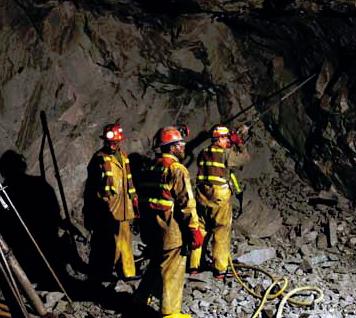
Sekoko Resources wants to extend its reach from exploration and development to supporting South Africa’s energy independence by harnessing the resources it can recover with emerging power generation technology. Jayne Alverca reports.
Diversity has been the hallmark of Sekoko since the company was founded in 2004. Its interests in South Africa’s Limpopo Province range from coal bearing properties in the Waterberg, Tuli and Mopane fields in the north, through to platinum reserves on the eastern and western limbs of the Bushveld igneous complex in the south, and iron ore in the Capricorn region, north of Polokwani. To complete the energy cycle, Sekoko is also closely examining the application of new sustainable technologies which will see it diversifying into oil production and power generation during the next decade.
Much of the portfolio is still at the initial exploratory phase; however, in a recent landmark announcement, Sekoko’s flagship project, the Waterberg coal project, has received the green light for development in a joint venture with Firestone Energy, an independent Australian exploration company. The two companies have recently signed a shareholders’ joint venture agreement to develop Waterberg, declaring in a joint statement issued in February 2011 that the decision was based on the economic robustness of the venture as indicated by extensive studies.
The Waterberg coal reserves are located on eight farms in an area of just under 8,000 hectares and represent one of South Africa’s largest undeveloped coal deposits. When in full production, Waterberg will produce approximately three million tonnes per annum of washed export-grade coking coal, destined principally for China and India.
The project is expected to start production at about 43,000 tonnes in April 2012, ramping up to 83,000 tonnes in April 2015. It comprises all eight farms in the Waterberg coal field and entails the construction of an open-cast coal mine on the Smitspan farm. The feasibility study had shown that Smitspan alone contains sufficient coal to produce around 120 million tons of coal for power stations, with some of the higher grade coal suitable for the metallurgical and thermal export markets.
However, a major feature of the development will focus on opportunities to progress up the value chain into gasification technology, with the economic potential for the production of power, chemicals and liquid fuels. Sekoko believes it can make an important contribution to South Africa’s drive towards lessening its reliance on energy imports, particularly oil. Even before civil unrest and revolution took hold in the Middle East, oil production was struggling to keep pace with rising world demand. South Africa depends on oil for over half of its consumer energy and 70 per cent of its transport energy—and most of this oil is imported.
Long term forecasts suggest demand for coal will increase strongly as pressure on oil supplies and prices continues to mount. The potential to utilise coal to offset petroleum consumption in the transportation sector is viewed as critical to South Africa’s long term economic future.
In response to these challenges, Sekoko is exploring the development of an integrated standalone greenfield coal-to-liquids (CTL) and co-generation power facility that could produce approximately 50,000 barrels of synthetic fuel and 300 megawatts of power per day based on the coal assets contained at the Waterberg project.
CTL is a proven technology capable of converting coal into gas and synthetic fuels, and the associated combined-cycle power units have been shown to produce around 20 per cent less CO2 than conventional coal fired plants—a figure that can be further reduced with carbon capture technology. However, the company believes that future generations of carbon capture technology could potentially reduce CO2 emissions to zero. A shift towards this form of power generation would not only support South Africa’s energy security, but would also make a contribution to greater environmental sustainability.
The company believes it can also harness new sustainable technologies at its magnetite iron ore project in the Capricorn region. This project involves the development of a greenfield open-cast iron ore mine in the Polokwane area. Here, Sekoko is targeting an unweathered magnetite quartzite resource of between 300 million and 600 million tonnes, which is thought to be capable of producing approximately 20 million tonnes of magnetite concentrate per year. Preliminary metallurgical tests have delivered excellent results, showing high recovery levels and minimal contamination.
The iron ore will be extracted by conventional methods from a series of open pits. Once crushed, a second phase of the development envisages the development of a sustainable iron ore smelter facility. The company is currently undertaking a study of how new technology could enable the smelter to use iron ore fines directly, without the need to sinter or pelletise, and enable the recycling of iron-bearing wastes. Drawing on the coal reserves at its disposal, Sekoko is also investigating how coal could be introduced directly, with no coking or other thermal pre-treatments.
Meanwhile, there are still other promising projects in the pipeline. The Tuli coal project is still at the initial exploration stage, and Sekoko continues to investigate two platinum bearing sites. One, at Sekhukhuneland on the eastern limb of the Bushveld complex—the world’s largest known reserve of platinum—is located mid-way between two well established and productive mines. Efforts at the second platinum project, on the western limb of the Bushveld complex near Thabazimbi, have focused on assessing, exploring and evaluating the mineral resources for commercial exploitation.
The development of these reserves can be expected to show a similar flair for innovation. A strong environmental and technological focus are key elements of future strategic plans and Sekoko is determined to demonstrate that an ethical approach to business can be compatible with maximising the value of its assets.
DOWNLOAD
 Sekoko_MAR-APR11_emea_BROCH_s.pdf
Sekoko_MAR-APR11_emea_BROCH_s.pdf













